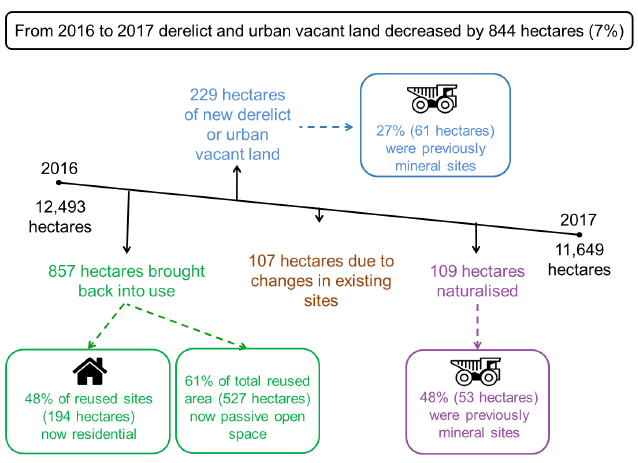Publication - Statistics
Scottish Vacant and Derelict Land Survey 2017
Data collection survey undertaken to establish the extent and state of vacant and derelict land in Scotland.
This document is part of a collection
2 Main Points

- The total amount of derelict and urban vacant land in Scotland has decreased by 844 hectares (7%) in the latest year, from 12,493 hectares in 2016 to 11,649 hectares in 2017.
- The net decrease of 844 hectares (7%) between 2016 and 2017 is the result of 857 hectares being brought back into use (includes 514 hectares of former Royal Ordnance sites in Renfrewshire), 109 hectares recorded as naturalised, the addition of 229 hectares in new sites and a net decrease of 107 hectares as a result of changes to existing sites.
- Of the 11,649 hectares of derelict and urban vacant land recorded in the 2017 survey, 2,075 hectares (18%) were classified as urban vacant and 9,574 hectares (82%) were classified as derelict.
- For those sites where the previous use is known, 38% of derelict land recorded in 2017 had been previously used for mineral activity (3,559 hectares), 21% for manufacturing (1,922 hectares), and a further 14% for defence (1,260 hectares). For urban vacant land, where previous use is known, the largest area was previously in residential use (17%, 302 hectares) and the second largest area had a previous use for agriculture (16%, 279 hectares).
- Of the 229 hectares of new derelict and urban vacant land reported by local authorities, the largest area had previous land uses related to mineral activity, 61 hectares, 27% of new land reported.
- East Ayrshire has the largest amount of recorded derelict and urban vacant land, with 2,401 hectares (21% of the Scotland total). Highland has the second largest amount with 1,342 hectares (12%), North Ayrshire is third with 1,335 hectares (11%), followed by North Lanarkshire with 1,282 hectares (11%) then Glasgow City with 1,069 hectares (9%).
- 29.8% of Scotland’s population are estimated to live within 500 metres of a derelict site in 2017, this varies by local authority area from 0.9% in Shetland and 1.0% in Orkney to 61.7% in Glasgow and 75.8% in North Lanarkshire.
- 59% of people living in the most deprived decile in Scotland are estimated to live within 500 metres of derelict land, compared to 12% of people in the least deprived decile.
- 2,685 hectares (25%) of derelict and urban vacant land in 2017 was reported to be developable in the short term, with an expectation of development within five years. A total of 2,784 hectares (26%) of derelict and urban vacant land is seen by local authorities as being uneconomic to develop and/or is viewed as suitable to reclaim for a ‘soft’ end use (i.e. non-built use).
- The most common use for derelict and urban vacant land brought back into use since the previous survey was residential, with 152 of the 317 listed reused sites (48%) reclaimed for this purpose - covering 194 hectares. The largest area of land was brought back into use as passive open space, 527 hectares (61%) – 506 hectares of this was a single former Royal Ordnance site in Renfrewshire.
- Of the 857 hectares of derelict or urban vacant land reused in 2017, a total of 62 hectares (7%) involved some form of public funding, either a full or partial contribution.
- Since its inception in 2005/06, the Scottish Government’s Vacant and Derelict Land Fund has contributed (either fully or partially) to the reuse of 386 hectares (in total) of previously derelict and urban vacant land across Dundee City, Glasgow City, Highland, North Lanarkshire, South Lanarkshire and more recently Fife.
- The total amount of derelict and urban vacant land has decreased each year between 2011 and 2017 (annual decreases ranging from 1.2% to 6.8%), except for 2014 when there was an increase of 2,090 hectares (18.8%) compared to 2013, largely due to over 2,200 hectares of former surface coal mine sites in East Ayrshire that had become derelict following the liquidation of Scottish Coal and ATH Resources in 2013.
- There has been a cumulative increase of 258 hectares (2 per cent) in the total amount of derelict and urban vacant land recorded since 2011 - from 11,391 hectares in 2011 to 11,649 hectares in 2017. However when excluding derelict mineral sites there has been a cumulative decrease of 1,393 hectares (15%) in the total amount of derelict and urban vacant land since 2011.
Contact
There is a problem
Thanks for your feedback